How to Remove Concrete Sealer From Stamped Concrete
How to Remove Concrete Sealer – Complete Tutorial on Stripping Sealer
March 15, 2021 Categorie(s): Guide
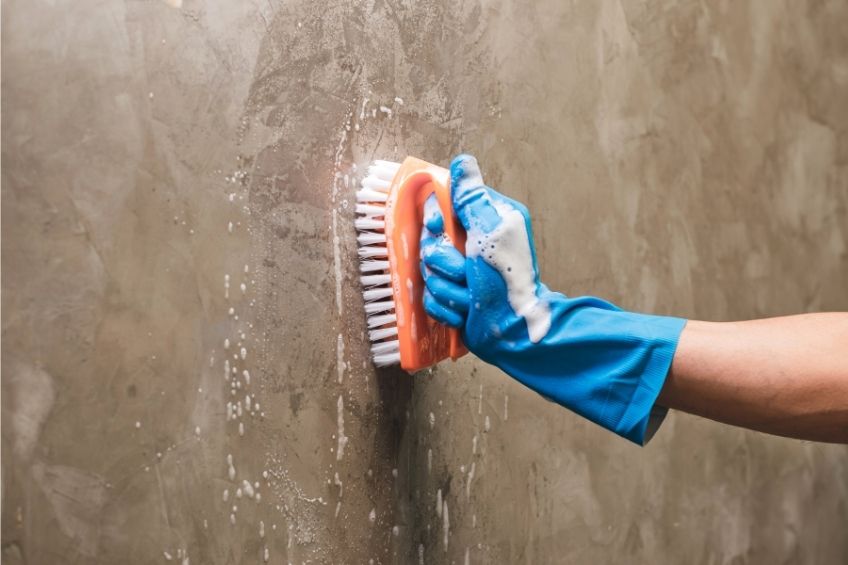
Concrete sealer is necessary for many surfaces and projects. One of the best things about using sealer on concrete is that it is really long-lasting and durable. However, this also means that when you need to remove it, it can be a seriously difficult task! Knowing how to remove concrete sealer is important if your sealer is old, worn, damaged, faded, or it just doesn't look the way you want it. Removing sealer from concrete may be a bit of a tedious process, but it is certainly possible with the right technique and tools. We have put together an extensive guide on how to remove concrete sealer below to help make the process as easy as possible.
Inhaltsverzeichnis
- 1 Understanding Concrete Sealer
- 2 Where Do You Find Concrete Sealer?
- 3 When Must Concrete Sealer Be Removed?
- 4 Different Types of Concrete Strippers
- 4.1 Caustic Strippers
- 4.2 Solvent-Based Strippers
- 4.3 Biochemical Strippers
- 5 Removing Water and Solvent-Based Products
- 5.1 How to Find Out Which Concrete Sealer Was Used
- 6 The Best Concrete Sealer Removers
- 6.1 AQUA MIX Sealer and Coating Remover
- 6.2 STONETECH Epoxy Grout Haze and Coating Stripper
- 6.3 BLUE BEAR Pro Coating Remover
- 6.4 MG CHEMICALS Conforming Coating Stripper
- 6.5 SUNNYSIDE Multi-Strip Advanced
- 7 How to Remove Concrete Sealer
- 7.1 Mechanical or Chemical Removing
- 7.2 How to Remove Concrete Sealer: Water-Based
- 7.3 How to Remove Concrete Sealer: Solvent-Based
- 8 Tips and Tricks for Concrete Sealer Stripping
- 9 Frequently Asked Questions
- 9.1 How to Remove Acrylic Sealer From Concrete?
- 9.2 Is Removing Concrete Sealer With Muriatic Acid Possible?
- 9.3 Can You Remove Concrete Sealer With Vinegar?
- 9.4 How Long-Lasting is Penetrating Concrete Sealer?
Understanding Concrete Sealer
Before learning how to remove concrete sealer, you will need to understand exactly what the concrete sealer is and how it works. A concrete sealer is a product used to protect the cement from water and salt damage. While concrete is a seriously durable substance, it can also easily absorb moisture and salts. This is because concrete is very porous. Any moisture that does not escape can soak into those pores and cause stains and damage – such as cracking, chipping, and so on.
Concrete sealer is applied to provide a protective barrier against this to help protect and maintain the natural appearance and strength of the concrete. This is a durable, long-lasting substance that provides water-resistance and protection against weathering. It is designed to resist being removed by the elements which are what makes purposefully removing concrete sealer a fairly laborious task.
Concrete sealer comes in two different varieties. First, there is penetrating concrete sealer. This type of sealer soaks into the pores of the concrete, fills them up, and dries to prevent any moisture from entering the pores. A deep penetrating concrete sealer is not always visible from the outside, but it provides a high level of protection internally. This type of sealer is particularly durable for maintaining the structural integrity of cement.
Topical concrete sealers are the other type. These sealers are applied over the surface of the concrete and they form an external protective barrier. Topical sealers can be thought of as a kind of varnish for your concrete. They often form a visible glossy coating and are designed to repel water and stop it from entering the concrete. This type of sealer is often less durable. When removing sealer from concrete, this type of sealer is easier to take off.
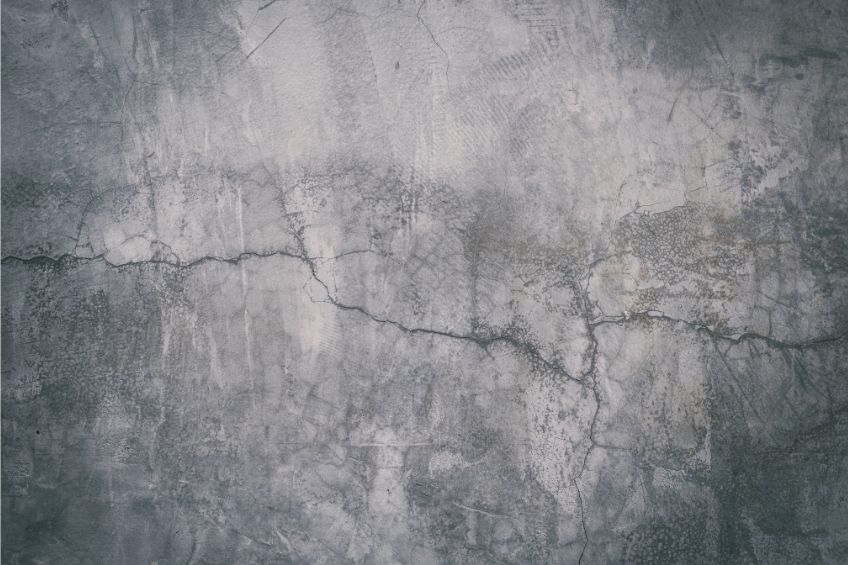
Where Do You Find Concrete Sealer?
Cement is one of the most common building materials and it is not always sealed. So, what surfaces are sealed with a concrete sealer? This product is mostly used outdoors to protect concrete against weathering, although it is also used indoors for decorative effects. It can be applied to walls, floors, brickwork, decorative objects, and all sorts of masonry work. If the cement is exposed to potentially damaging factors, then a concrete sealer is applied.
If you see cement, bricks, or masonry with a shiny, glossy, wet-look effect, then they are sealed with a topical product. You can notice this type of sealer by the smooth appearance it offers over the concrete. If the concrete has large visible pores, cracks, and gaps, then it is most likely not sealed. Not all concrete needs to be sealed, but it is highly recommended for protecting the surface for a longer lifespan.
When Must Concrete Sealer Be Removed?
Clearly, a concrete sealer is a useful product that is designed to enhance the properties of cement and masonry. So, under what circumstances should you remove it? Even though it is a durable and long-lasting substance, concrete sealer is not designed to last forever. Over time, the sealer will eventually start to wear and tear and fade away. When exposed to plenty of weathering, the concrete sealer might fade, wear down, or get damaged. If this is the case, you will probably need to know how to remove concrete sealer before you can reapply a new layer.
The other reason is purely aesthetic. You might have bought a new house or changed your taste, and suddenly you are faced with sealed concrete that you do not like the look of anymore. As mentioned earlier, a concrete sealer can provide a unique finish to cement and masonry surfaces. If you do not like this finish, then you will need to remove it. You may also need to learn how to remove concrete sealers when doing various types of renovations or DIY projects when the finish needs to be taken out.
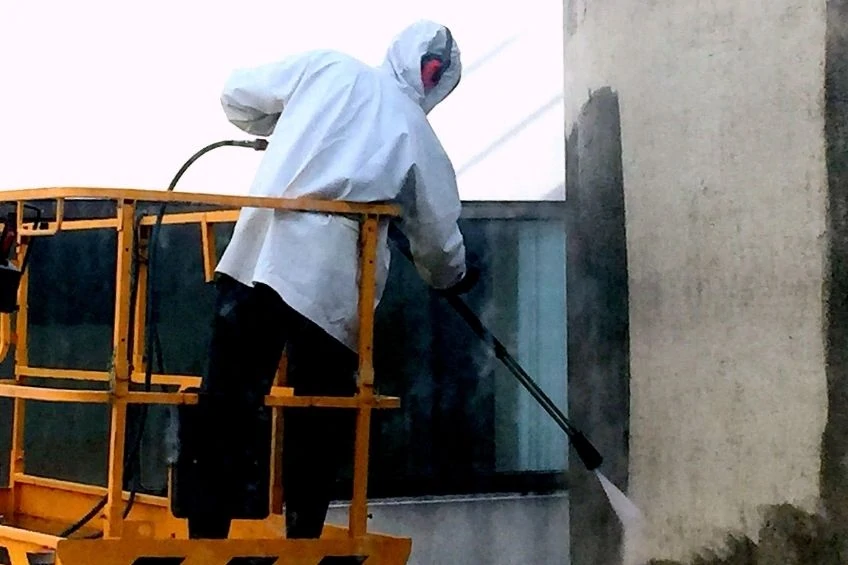
Different Types of Concrete Strippers
When learning how to remove concrete sealer, one of the most common approaches is to use a concrete stripper. These chemical products can be categorized into three different groups. Each of these types of strippers will contain potentially dangerous chemicals and require caution when using them. Even if the product is marked as being eco-friendly, there are still harsh chemicals included. We have outlined these three different types of strippers below.
Caustic Strippers
This type of concrete sealer remover uses a high pH alkaline chemical formula. This type of product is generally safer to use than a solvent-based product. It may involve quite a few coats before you achieve successful results. After you have used a caustic stripper, you will need to do a neutralizing wash over the concrete in order to return and balance the pH levels.
Caustic strippers can be used to remove alkyds, enamel, or latex paints. They do not work well against substances with a high resistance level to caustic chemicals. This includes acrylics, polyurethane, and epoxy coatings.
Solvent-Based Strippers
Most strippers are solvent-based products. The reason that this type is so popular is that they are very efficient and fast working. You only need a small amount of solvent-based stripper to remove the sealer from a large surface area. There are various different types of solvent-based strippers available, but the most common would be methylene-chloride-based products. Solvent-based strippers work best when they are used with water.
The benefits of these products are that they are seriously aggressive and fast-working. Solvent-based strippers can be used over basically any type of sealer, and they generally achieve the strongest results. The downside is that these substances can be very toxic and harmful, and so plenty of precautionary care is required when handling them.
Biochemical Strippers
Biochemical strippers have become very popular products thanks to their environmental friendliness. These products are made from plant materials and they have the lowest environmental impact. Biochemical strippers have the major advantage of being the safest products available – producing very low odors and containing few harmful chemicals. The downside to this is that biochemical strippers are also the least aggressive of all three different types.

Removing Water and Solvent-Based Products
Before learning the process of how to remove concrete sealer, there is one more essential consideration to understand. This is the type of concrete sealer formula that you will be removing. No matter what style of concrete sealer, the product can either be water-based or solvent-based. Both of these have unique characteristics, and both will require different concrete removal products and methods.
Water-based concrete sealers do not contain solvents. These types of sealers are generally easier to remove as they contain fewer chemicals and are not always as durable. Water-based products are also safer to work with. When using a water-based concrete sealer that is still wet, it can be simply cleaned up using soapy water. When cured, you will need less intensive removal products and chemicals.
Solvent-based concrete sealers can be a little bit more tricky. Unlike water-based products, these sealers contain a high amount of solvents and VOCs. Solvent-based products are generally a bit more durable than water-based products, with stronger adhesion properties. As they are designed for more resistant use, they are often trickier to take out. Harsher, stronger chemicals will be needed to remove them. When working with solvent-based products that are still wet, they will need chemicals to clean up. They can also emit strong odors and can be more harmful to work with.
How to Find Out Which Concrete Sealer Was Used
Before you can learn how to remove concrete sealer, it is essential to know whether you will be removing a water-based or solvent-based product as both of these require unique removal methods. So, how do you know what type of sealer is used? If you did not apply the product or if you forgot, then you can figure it out by doing the following test.
Find an area of the concrete or masonry that is still coated by the sealer. Take some xylene, and pour a very small amount over the sealed area. Leave the xylene to sit on the surface for about 20 seconds, then wipe it away.
Now you just need to touch this area to find out. If the area is now a little bit sticky or tack, then you know that there is a solvent-based concrete sealer at use. If the area is dry and not at all sticky, then it is a water-based sealer.
So, when learning how to remove concrete sealer, there are two important questions you will need to ask. First, is the concrete sealer a deep-penetrating type, or is it a topical product? And is the product used water-based or solvent-based? Once you have answers to both of these questions, you can start to choose the right products and best methods of removing the sealer.
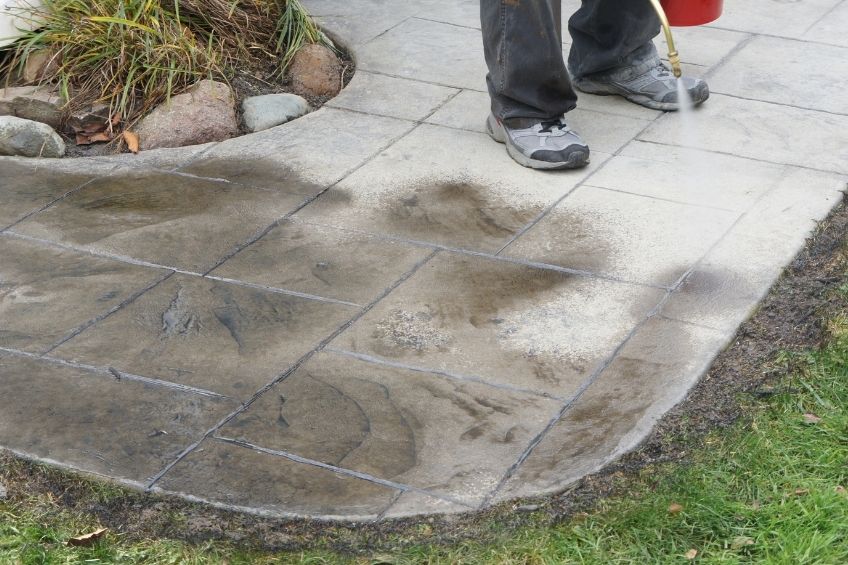
The Best Concrete Sealer Removers
When learning how to remove concrete sealer, the first step is to get the right concrete sealer remover product. Of course, this differs depending on the specific type of concrete sealer that you will be removing. For a general range of excellent concrete sealer removers, you can choose between the products highlighted below.
AQUA MIX Sealer and Coating Remover
This is a really versatile product to use over many different types of sealers and coatings that need to be removed. In terms of concrete sealers, this product is ideal for all water-based sealers. The Aqua Mix Sealer and Coating Remover can also be used to clean stains, strip paint, and wipe away residual adhesives. This is a seriously versatile product to have in any DIY enthusiast workshop.
The sealer remover is safer to use than many other products. The completely non-flammable stripper powerfully removes various finishes, sealers, and coatings with its long working time. This product is ideal for all kinds of tough projects. Some surfaces that this product can be used over include marble, granite, travertine, slate, porcelain, ceramic, concrete, grout, and more. The multi-purpose stripper is designed to stay wet longer in order to remove the toughest coatings. It also does a great job of removing heavy grease build-up over surfaces.

- Cleans deep-set stains, epoxy grout haze, adhesives & paint
- Effectively removes sealers, coatings, and finishes
- Has a long dwell time for better results
View on Amazon
PROS
- A versatile sealer and coating remover
- Safe to use and non-flammable
- Highly effective over various surfaces
- Designed to stay wet for longer
- Can be used for multiple purposes
CONS
- You need to be very careful when working with it because the aggressive stripper can remove or damage all other surfaces it comes into contact with
- A more expensive stripper and remover
STONETECH Epoxy Grout Haze and Coating Stripper
This heavy-duty cleaner can be used over all-natural stone, tile, and concrete surfaces. The product comes in the form of a gel and it work seriously quickly. Sealer can be stripped away in ten minutes. This special cleaner and stripper has been designed for versatile use and can remove epoxy grout haze, varnish, lacquer, adhesives, and more.
This remover is a water-based gel, so it is only really effective when removing water-based sealers. It can be used on all kinds of vertical and horizontal surfaces and works very quickly for removing tough substances. As this is specially designed for masonry, it is the ideal formula for maintaining and preserving your concrete without causing any damage.

- A stripper for natural stone, tile, and masonry
- A fast-acting gel that can clean in ten minutes
- A versatile stripper that removes various adhesives and substances
View on Amazon
PROS
- A heavy-duty formula for stripping various substances
- Can be put to versatile use
- Fast-acting formula
- A water-based gel that is safe to use
- Suitable for many different surfaces
CONS
- Requires quite a lot of scrubbing for it to be effective
BLUE BEAR Pro Coating Remover
Blue Bear is a well-trusted brand when it comes to substance strippers and removers. Their Pro Coating Remover is perfectly formulated for removing concrete sealers. This effective stripper is free from methylene chloride or NMP. It can be used to remove a wide range of diferent finishes and coatings in multiple layers. You can effectively use this product over many water-based concrete sealers. This product is formulated to be safe to use, eco-friendly, and low odor. Just be aware that any concrete surfaces used with the Blue Bear Pro Coating Remover may darken slightly after exposure.

- An industrial-strength multipurpose coatings remover
- No NMP or methylene chloride formula for safer use
- Low odor and perfect for indoor use
View on Amazon
PROS
- An effective coating remover formulated for use on masonry
- Can remove thick layers
- Eco-friendly formula
- Low odor
- A versatile coating remover
CONS
- Can darken concrete after application
MG CHEMICALS Conforming Coating Stripper
This powerful chemical remover can be used to strip a wide range of coatings. It can be used on acrylics, polyurethanes, and silicones. The formula is completely safe to use on most PCB types, and it is safe for use on metals. The formula contains no SVHCs and is completely biodegradable. This makes it safer to work with.
This coating stripper doesn't work on all types of concrete sealers, so you will need to make sure that the formula you are working with can match this stripper. It is also only designed to soften the coating so that you can mechanically remove it. This means that it is only suitable for topical concrete sealers. When used correctly though, this product can prove to be very effective.

- An easy to use conformal coating stripper
- Effectively removes a wide range of coating types
- Fully biodegradable and environmentally friendly
View on Amazon
PROS
- Strips a range of different products
- Good value for money
- Safe to use
- Biodegradable
CONS
- Not suitable for all concrete sealers
- Still requires mechanical removal after application
SUNNYSIDE Multi-Strip Advanced
This product by Sunnyside is formulated to be a multi-purpose paint stripper. Although no specifically designed for use on concrete sealers, it can be used to achieve effective results thanks to its versatile formula. The stripper is formulated with methylene chloride or NMP for a safer formula. It contains no caustics, has a low VOC count, produces a low odor, and is regarded as an environmentally-friendly product. This stripper can also be cleaned up easily with water. It is not suitable for use on solvent-based concrete sealants though.
The Sunnyside Multi-Strip Advanced begins working in half an hour and can remove up to 15 layers of paint, varnish, urethane, lacquer, and more. The strong formula can be applied with a brush and should be coated on quite heavily. It can adhere to vertical surfaces too. This formula can be used on sealants over a wide range of materials other than just concrete. It is a really useful product to have in your garage or workshop as it can be used for multiple stripping and removing jobs.

- A safe to use professional varnish and paint remover
- Capable of removing up to 15 layers of paint or finish
- Adheres to and works on a wide range of surfaces
View on Amazon
PROS
- A safer, more environmentally-friendly formula
- Can be used for various stripping and removal jobs
- Good value for money
- Effective in removing thick coats
- Low VOC and low odor formula
CONS
- This product is designed as a paint stripper, so it does not work for all concrete sealers
- Requires more than one application
How to Remove Concrete Sealer
Now that we know what the best concrete sealer removers are and how to choose them, it's time to go over how to remove concrete sealer. Concrete sealer stripping can be a very laborious process. Whatever method you take depends on the type of sealer you are dealing with and its specific condition. When removing sealer from concrete, here are a few basic processes to follow.
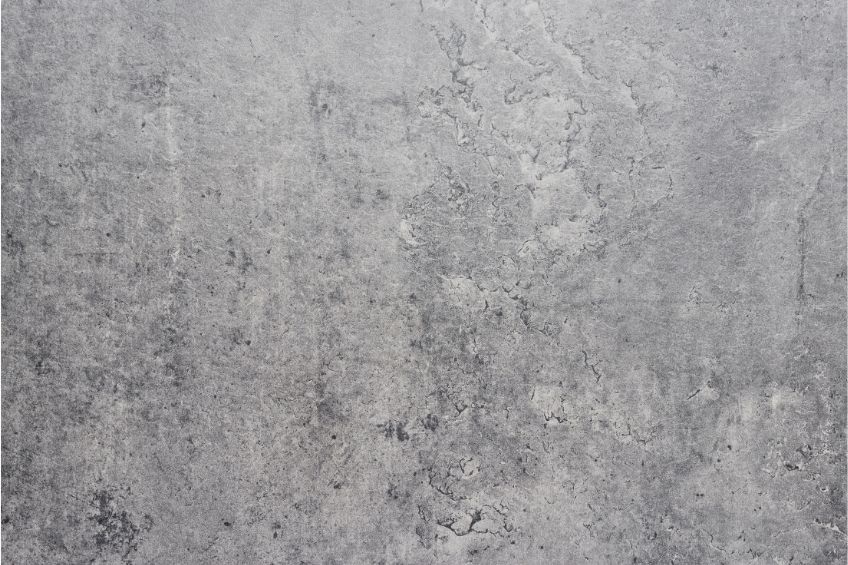
Mechanical or Chemical Removing
When removing sealer from concrete, there are two different approaches you can take. You can either do mechanical stripping or chemical stripping.
The mechanical process is when you physically scrape off the sealer from the concrete. This can include grinding the concrete, sanding down its surface, or blasting it to remove the sealer. The chemical process is when you use a special chemical product, or stripper, to soften and remove the sealer. Often, a combination of both techniques is used.
How to Remove Concrete Sealer: Water-Based
When removing a water-based concrete sealer, start by applying an appropriate stripper. Apply this to the sealer and leave it to work on the sealer. Follow the product instructions on this. You could also use an acid etching solution on the sealer, and then neutralize the concrete. Once the sealer has softened the concrete, you can then scrape any remaining sealer off with a mechanical approach.
How to Remove Concrete Sealer: Solvent-Based
First, try to scrape away any concrete sealer that might be flaking or chipping away. When you can't physically remove any more, then apply a solvent-based concrete stripper. Try to use a more aggressive product. Let the stripper soak in and then scrape away any additional sealer left. For a solvent-based sealer, you may need to apply more layers of the stripper.
The process of concrete sealer stripping follows the same general idea: applying a stripper to the concrete and scraping away any sealer left behind. The important thing is that you get the right stripper for the type of sealer that you will need to remove.
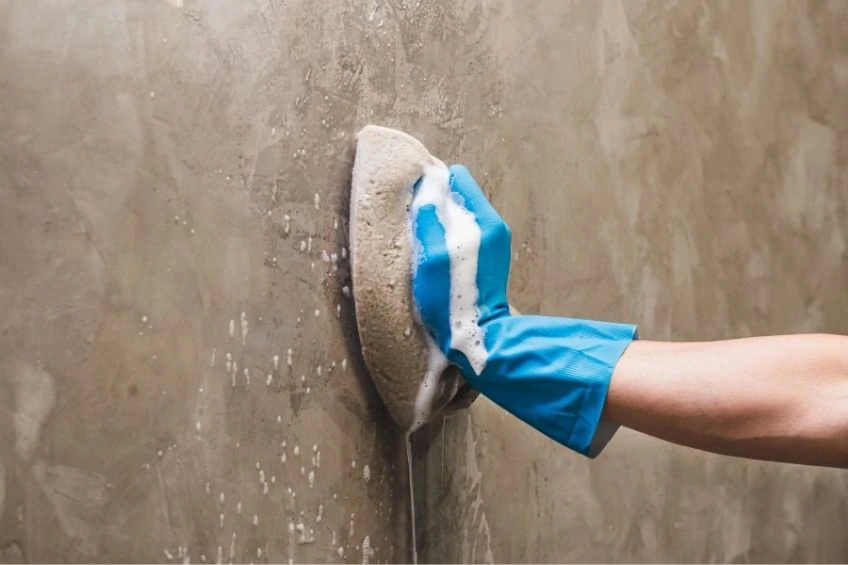
Tips and Tricks for Concrete Sealer Stripping
Knowing how to remove concrete sealer is essential for anyone wanting to renew their concrete sealer surface. When removing sealer from concrete, the process you take will differ with each project. Here are some useful tips and tricks to help make the removal process easier and more effective.
- When learning how to remove acrylic sealer from concrete, you can always just try to reseal it first. An acrylic sealer that is solvent-based can be used over the previous layer without needing to remove it.
- Old and faded water-based sealers can sometimes simply be removed by pressure washing them. You don't always have to use a chemical stripper if the water-based sealer is already starting to flake off.
- To keep the sealer active, you can cover it with a damp cloth or piece of material. This will help the sealer to work for longer.
- When removing sealer from concrete outdoors, try not to expose the stripper to too much sunlight.
- It's best to apply chemical strippers in small amounts and not in one large area. Doing it in more manageable sections makes it easier to control and clean up.
- When scraping away concrete sealer, it can be best to use a stiff bristles brush. This helps to get into the pores of the concrete to remove any deep penetrating sealers.
- Take the proper protective measures. Chemical strippers can be very harmful products, so you always need to handle them with care. When stripping concrete sealer, always wear protective gloves and wear a respirator mask to avoid inhaling any fumes.
- Read the instructions! This is a simple piece of advice but it is so important. Each concrete sealer remover is unique and involves a different process. Make sure that you are familiar with the product and how it works before starting to use it.

Frequently Asked Questions
How to Remove Acrylic Sealer From Concrete?
Want to know how to remove acrylic sealer from concrete? You can either scrape it off mechanically or use a chemical stripper. If you use a stripper, make sure to use a solvent-based product for the best results. This is the best type of acrylic concrete sealer remover.
Is Removing Concrete Sealer With Muriatic Acid Possible?
Removing concrete sealer with muriatic acid can be done fairly effectively. You can do this by acid etching the concrete's surface with this acid and then doing a neutralizing wash to restore the pH levels of the concrete.
Can You Remove Concrete Sealer With Vinegar?
It is possible to remove concrete sealer using vinegar for a safer alternative. However, vinegar will not be as effective as an acrylic concrete sealer remover. We recommend using made-for-purpose chemical strippers to get the job done most effectively.
How Long-Lasting is Penetrating Concrete Sealer?
Deep penetrating concrete sealers are the longest-lasting, most-durable options. These types of sealers can last anywhere between 5 to 25 years. This depends on the product used, the weather conditions, and how effectively it was applied to the concrete.
Learning how to remove concrete sealer is necessary if you want to renew the concrete or reapply a layer of sealer. This may be a labor-intensive job, but with the right products and approach, it will be a whole lot easier. We hope that we have been able to answer all of your questions on this topic and help you to be fully prepared for your next project!
How to Remove Concrete Sealer From Stamped Concrete
Source: https://resin-expert.com/en/guide/how-to-remove-concrete-sealer